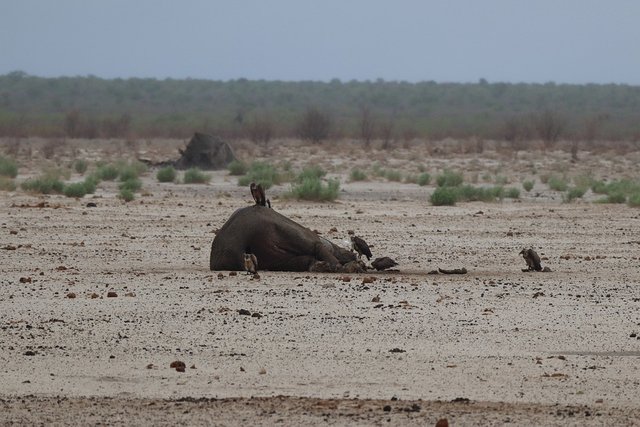The mass death of African elephants

Source
Being alert to anything that happens to a species such as illness, injury, stranding, poisoning, suffocation, entanglement and death, should call our attention. Being alert can help prevent harm or understand what happened at another time or place.
Through these episodes, we study and sharpen our feelings and our mind.
From May to July of this year 2020, the massive death of African elephants was observed, which proved to be identical circumstances.
Something to pay attention to, since there were more than three hundred African elephants. The news said that they succumbed in the African jungle of Botswana, each time they were added without an apparent bloody cause, it wasn't hunting, we didn't know why.
It has been a mystery, something that did not manifest itself at first sight, nothing macroscopic, there was regret and uncertainty. We went to science, we had to do scientific research, autopsies, biochemical, bacteriological and microbiological studies.
A lot was expected, but the results are in. Botswana's Department of Wildlife and National Parks said the death of the pachyderms in the Okavango River Delta was due to ingesting water containing cyanobacteria.
From the kingdom of bacteria, cyanobacteria are species that can produce oxygenic photosynthesis (that's why they were previously included among algae) and are also capable of producing toxins. Toxins are products of living beings, which can produce damage or disease to other living beings. It was the German Ludwig Brieger who introduced the term toxin in his book "Veber Ptomaine".
Cyanobacteria reproduce in waters where nutrients (nitrogenous compounds) are excessive, with high relative or absolute temperatures. These cyanobacteria would be equivalent in the ponds, to the algae that produce the Red Tide in our seas. Like the Dinoflagellates that make up the Red Tide, the cyanobacteria produce toxins that affect the species that go to drink the water of the lagoons and ponds that serve as drinking fountains to quench their thirst.
Cyril Taolo, spokesman for Botswana's Environment Department, explained that when the drought ends, many ponds dry up. In the ponds that manage to persist have fallen feces and urine of the user species, a source of nitrogenous substances, food conducive to the development of colonies, prepared is the breeding ground for cyanobacteria.
The elephants had to select without knowing that these ponds and lagoons were affected by the "flowering" of cyanobacteria, obviously to save their thirst. When the families or herds of African elephants drank the water, it was contaminated with cyanobacteria and their toxins. Unfortunately, the pachyderms became ill and died.
The Bostwana environmental spokesperson consoled us with the quantification of the elephants in that country. He reported that in his country there are still about one thousand two hundred and fifty African elephants which are in good condition.
As our speculation, this could shed light on the causes or some factors that contributed to the extinction of mammoths and mastodons. Especially, of the latter, the mastodons that existed in our beloved country, Venezuela, with evidence that they were in the Sierra de Perijá, Sierra de Los Andes, Maciso Lara-Falcón, in the Cordillera de La Costa in Carabobo and Aragua, in Orierte and the state of Bolívar. That was until about ten thousand years ago. Although there is only evidence of two fossils that could have been hunted and eaten by humans, it could not explain the disappearance of the mastodons in our country.
But when the Orinoco River took a new path, heading east, the abundant biological diversity was forced to drink water from sewage ponds. Perhaps the same could have happened to the mastodons, just as it did to the African elephants of the Okavango River Delta.
It's unfortunate that this is happening at the same time it is interesting how it seems that the nature itself takes measures to control species I was also surprised by the fact that we had mastodons and those parts of the country.A very interesting read, I congratulate you.
Sorry for the delay in answering you, my connection is taking a vacation for days. Certainly nature is wise and applies its own controls and they are not as unreasonable as those applied by hum
Hello friend, it is something really sad these animals have always suffered this kind of mistreatment. I believe that a lot of humanity and conscience is needed, animals should also be valued.
In this case death is by natural selection, but certainly man is a great exterminator of this species
This is really sad, human activities have been going against nature for a long time now and I just feel that more awareness has to be created to prevent the constant loss of these animals who are trying to survive.
Humanity is predatory and it is difficult to control this natural instinct.
Hello friend, it is very sad and regrettable that this kind of mistreatment for our wild fauna still exists, these wonderful species must be treated the same way we like to be treated, they are also living beings, let's have a degree of consciousness and not damage our space. Greetings
Greetings, in this case it is not about human abuse but certainly we must create awareness to be able to interact with nature